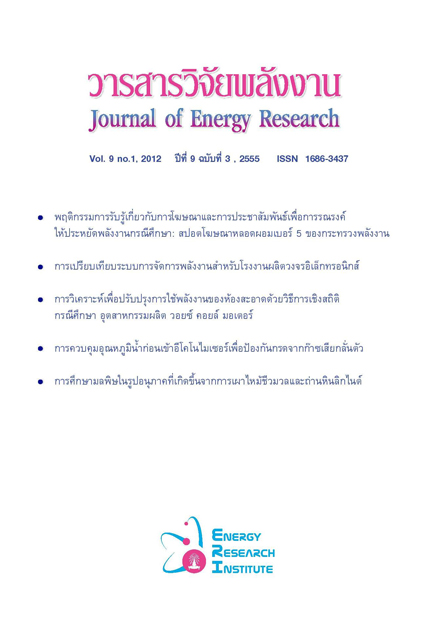พฤติกรรมการรับรู้เกี่ยวกับการโฆษณาและการประชาสัมพันธ์เพื่อการรณรงค์ให้ประหยัดพลังงาน กรณีศึกษา: สปอตโฆษณาหลอดผอมเบอร์ 5 ของกระทรวงพลังงาน
Main Article Content
Abstract
การวิจัยนี้มีวัตถุประสงค์เพื่อศึกษาถึงพฤติกรรมการรับรู้เกี่ยวกับการโฆษณาและการประชาสัมพันธ์เพื่อการรณรงค์ให้ประหยัดพลังงาน กรณีศึกษา: สปอตโฆษณาหลอดผอมเบอร์ 5 ของกระทรวงพลังงาน ในชุด “ทราบแล้วเปลี่ยน หลอดผอมเบอร์ 5” โดยใช้แบบสอบถามในการเก็บข้อมูลจากกลุ่มตัวอย่างจำนวน 400 คน วิเคราะห์ข้อมูลทางสถิติด้วยโปรแกรมสำเร็จรูป SPSS for windows (Statistical Package for the Social Science) ผลการวิจัยพบว่า ลักษณะทางประชากร ได้แก่ อายุ ระดับการศึกษา และอาชีพที่แตกต่างกัน มีพฤติกรรมการรับรู้เกี่ยวกับการโฆษณา และการประชาสัมพันธ์เพื่อการรณรงค์ให้ประหยัดพลังงานที่แตกต่างกัน อย่างมีนัยสำคัญทางสถิติที่ระดับนัยสำคัญไม่มากไปกว่า 0.05 และการรับรู้ของประชาชนเกี่ยวกับการโฆษณาและการประชาสัมพันธ์เพื่อการรณรงค์ให้ประหยัดพลังงาน มีความสัมพันธ์กับพฤติกรรม อย่างมีนัยสำคัญทางสถิติที่ระดับนัยสำคัญ 0.01 นอกจากนี้ยัง พบว่า กลุ่มตัวอย่างที่มีอายุระหว่าง 19-25 ปี เป็นกลุ่มที่สามารถรับรู้และจดจำข้อความ เนื้อหาและประโยชน์เกี่ยวกับการโฆษณาและการประชาสัมพันธ์เพื่อการรณรงค์ให้ประหยัดพลังงานได้มากที่สุด และพบว่าการจัดกิจกรรมส่งเสริมและการให้สิ่งจูงใจ เช่น บัตรส่วนลดหรือของรางวัล สามารถก่อให้เกิดการเปลี่ยนแปลงพฤติกรรมเพื่อการประหยัดพลังงานได้ในทันที
PERCEPTUAL BEHAVIOR ACCORDING TO ADVERTISING AND PUBLIC RELATIONS ENERGY SAVING CAMPAIGN: A CASE STUDY–HIGH-EFFICIENCY T5 FLUORESCENT LAMP ADVERTISING SPOT OF MINISTRY OF ENERGY
Muttana Pimchot1, Damrong Thandee2 and Sompong Putivisutisak3
1Energy Technology and Management Program, Graduate School, Chulalongkorn University, Pathumwan, Bangkok
2Sociology and Anthropology Department, Faculty of Humanities, Ramkhamhaeng University, Bangkapi, Bangkok
3Mechanical Engineering Department, Faculty of Engineering, Chulalongkorn University, Pathumwan, Bangkok 10330, Thailand
The aim of the present study is to analyze perceptual response to an advertising and public relations campaign for the use of high-efficiency T5 fluorescent lamps. Our primary data collection tool was a questionnaire developed for the study sample of 400 people. The data from the questionnaire were analyzed by the SPSS software for Windows (Statistical Package for the Social Science). It is found that populations with different characteristics such as age, level of education, and occupation showed differences in perceptual behavior in response to advertising and public relations on energy saving campaigns at the level of statistical significance of values not more than 0.05. In addition, the perception of populations showed a relationship with their behavior, at the statistical significance level of 0.01. It is also found that the population sample of age between 19–25 years old was best able to recognize and remember the energy saving messages. It can be seen from the survey results that the most effective way to change energy saving behavior of the populations is to provide incentives such as discount promotions or rewards.

